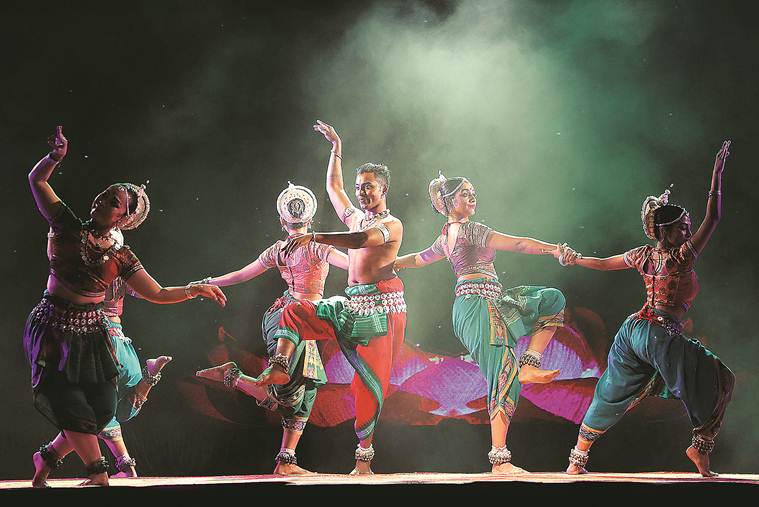- India
- International
The Master’s Steps
Malaysian legendary choreographer and Indian classical dancer Ramli Ibrahim on the piece, Odissi on High, cross-cultural collaboration and the power of movement.
 Ramli Ibrahim. (Express photo by Ashish Kale)
Ramli Ibrahim. (Express photo by Ashish Kale)
Clad in a saffron kurta and cream-coloured dhoti, Ramli Ibrahim walks in for our interview with a radiant smile. His expressions flow as he talks, with his gestures orchestrating his words. Ibrahim, a legendary Odissi dancer from Malaysia and recipient of the Padma Shri, visited Pune recently for a show called “Odissi on High: Boundless Verve & Audacity”. Sutra Foundation, which he founded in Kuala Lampur in 1983, collaborated with Rudrakshya Foundation from Bhubaneswar for the performance that was hosted by India House Art Gallery. The event was a tribute to well-known Odissi dance legends, Kelucharan Mohapatra and Deba Prasad Das.
Having trained in ballet, Malaysian folk and Bharatanatyam under Adyar K Lakshman, it was eventually Odissi that drew Ibrahim. In the pursuit of learning the form, he trained under Das and went on to excel on stage. Ibrahim experimented with the dance form, and explored realms within it. “The performance “Odissi on High” is a link between Malaysia and India. I believe this link is important because there is a growing connect between the two nations in terms of business. I have always believed that business and culture cannot exist in separation from each other especially since we are talking about Odissi; Kaling has been a historic trade capital,” he says.
Ibrahim has worked on this project with Guru Bichitrananda Swain, who belongs to Rudrakshya school. Thematically, it explores the evolution of Pallavi, a genre in Odissi repertoire. “The idea is manifested in two representational styles. These styles are the approaches developed by the two pioneer gurus, late Kelucharan Mahapatra and Deba Prasad Das. Bichi and I are disciples of these two gurus respectively,” he says. Sutra consists of Malaysian dancers, who are trained in ballet and other contemporary styles, while Rudrakshya is a centre in Odisha that embodies the traditional aspect of Odissi. “It’s an interesting blend and beautiful indeed,” he added. While teaching Malaysian students Ibrahim employs certain exercises such as walking 10 steps straight with karun rasa or expressing vatsalya rasa for 10 minutes.
 Ibrahim has given a new dimension to group compositions. (Express photo by Ashish Kale)
Ibrahim has given a new dimension to group compositions. (Express photo by Ashish Kale)
Many of Ibrahim’s performances have been conceptualised on verses. “I have done performances like Ragamurti, where I have explored the temptations of Buddha. Pieces like Ganjam have had anecdotal bases,” says Ibrahim. In his works, he has given a new dimension to group compositions. “In my group choreographies, there are a lot of formations inspired from contemporary forms. They are not just straight lines. Instead, I do a lot of diagonals and other formats. My approach has always been more eclectic. I have improvised on a lot of dynamics. And I have always accepted that I am a fairly modern and contemporary dancer. But, we need to refresh the meaning of modernity in that sense,” he says.
He adds that, when his group performs in India, “there are connoisseurs who comprehend the depth of the art form and the essence of its tradition. So, we have to be more careful”. “When we perform in Malaysia, it is more liberal.” he says. “Abhinaya is universal; rasa is universal. When the dancer feels and emotes, it reaches the audience, no matter what the geographic location is. It reaches them and it hits them on spot. I have had audience from global space who have come and spoken to me after performance because it moved them. This is the power of dance.”

On May 30, Ibrahim has a Bharatanatyam performance in Kuala Lampur. The piece, in which he has collaborated with two friends, is called Embattled, Emboldened and Empowered. “The name reflects on the journey of my co-dancers. They have been battling a lot of issues on personal front. They are emboldened because they always sought dance as their relief and they are empowered because they chose to engage with it again.”
Apr 26: Latest News
- 01
- 02
- 03
- 04
- 05




































